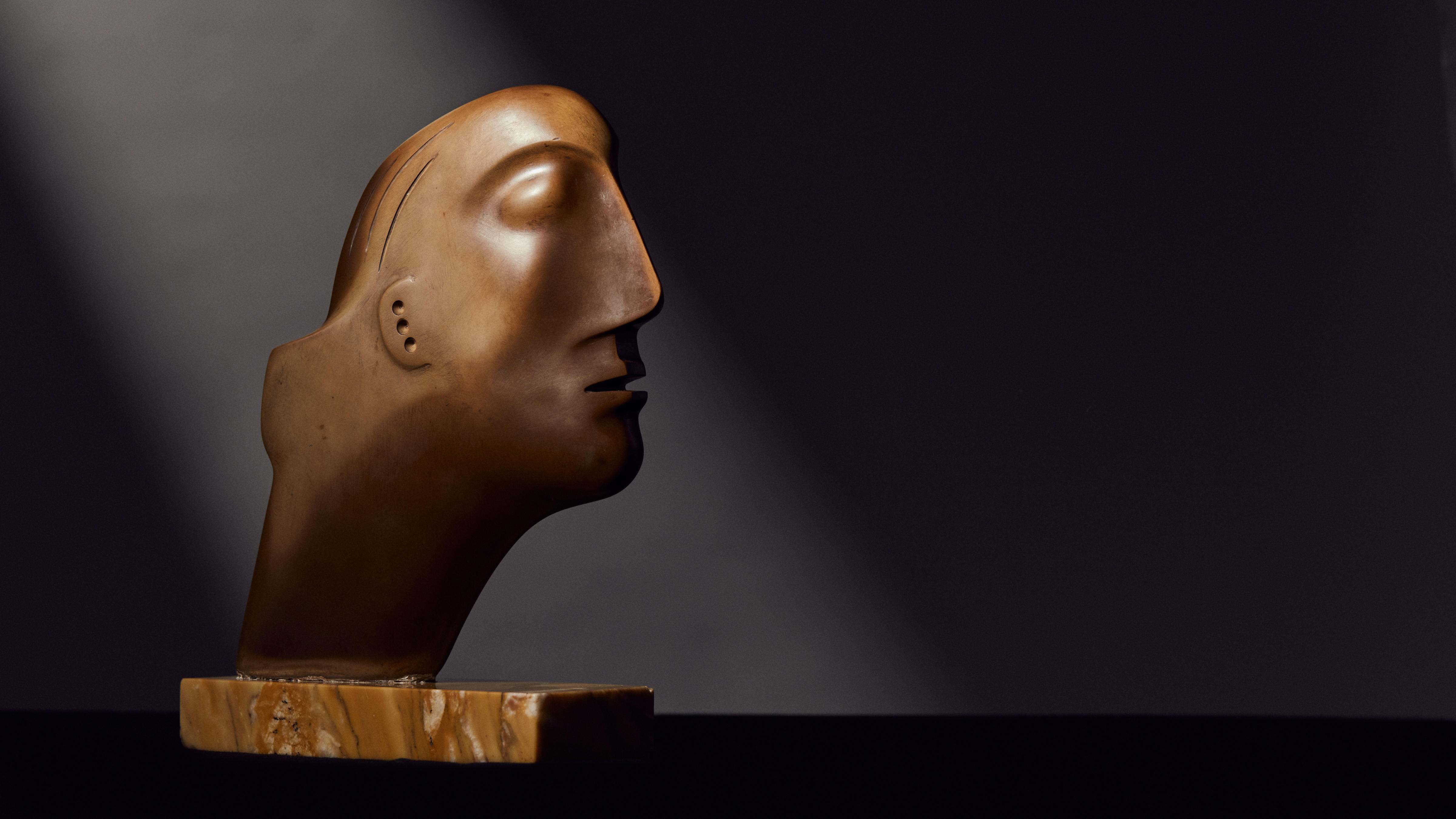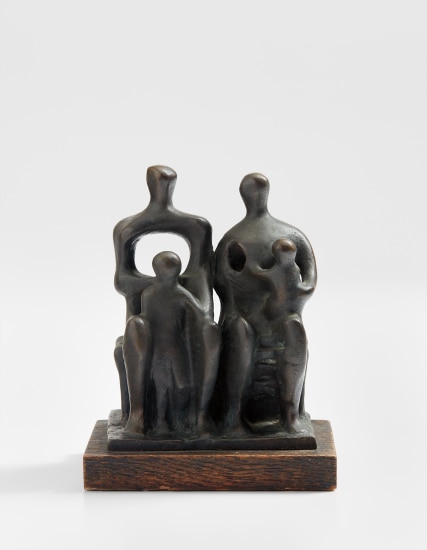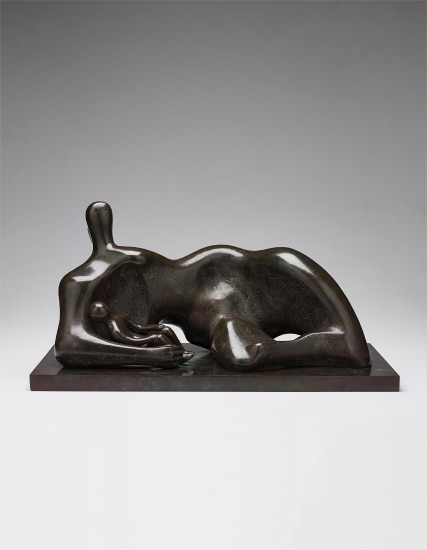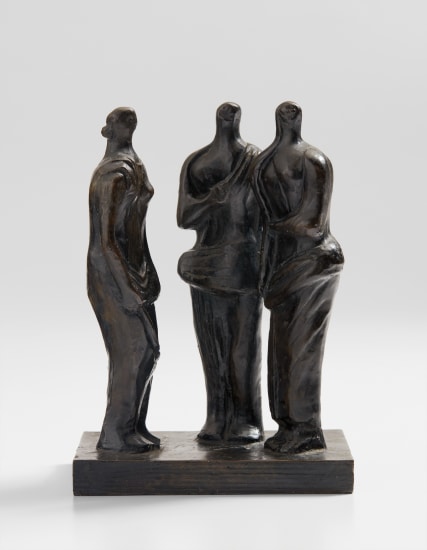HENRY MOORE (1898-1986) Reclining Figure: Pointed Legs inscribed and numbered 'Moore 7/9' (on the base) bronze 9 in (22.9 cm) (length) Conceived in 1979 Fußnoten This work is recorded in the archives of the Henry Moore Foundation. Provenance Adler Fielding Gallery, Johannesburg. Private collection, Seattle (acquired from the above). Literature A. Bowness, Henry Moore Complete Sculpture 1974-1980, vol. V, no. 777 (illustration of another cast n.p). "From the very beginning the reclining figure has been my main theme', Moore has declared. 'The first one I made was around 1924, and probably more than half of my sculptures since then have been reclining figures'" (H. Moore quoted in A. Wilkinson (ed.), Henry Moore Writings and Conversations, Aldershot, 2002, p. 212 The recumbent female form was a theme Henry Moore returned to throughout his nearly sixty-year career. "The human figure is the basis of all my sculpture," Moore professed, "and that for me means the female nude." Most of Moore's female figures are positioned seated or reclining, a configuration that initially stemmed from Moore's use of stone as his preferred medium and the structural weakness of the material in a standing figure's ankles. "But with either a seated or reclining figure one doesn't have this worry," Moore explained. "And between them are enough variations to occupy any sculptor for a lifetime... Of the three poses the reclining figure gives the most freedom, compositionally and spatially. The seated figure must have something to sit on. You can't free it from its pedestal. A reclining figure can recline on any surface. It is free and stable at the same time. It fits in with my belief that sculpture should be permanent, should last for an eternity" (D. Mitchinson, (ed.), Henry Moore Sculpture, with Comments by the Artist, London, 1981, p. 86). The beautifully modulating form for the present work exemplifies Moore's mastery of the bronze medium. Propped on her forearms with her attention directed to her left and legs facing a contra-direction, Reclining Figure: Pointed Legs is animatedly alert and captures an instant of the figure's movement. The motion evoked by the form's curvilinear shape endows the figure with a plasticity that seemingly defies the bronze medium. Although reclining, this brilliantly dynamic sculpture presents dramatic profiles when seen from various viewpoints. The points of the figure's head, breasts, and attenuated arms and legs are counterbalanced by the soft curves of the woman's arching back, stomach, and propped legs. The recumbent woman is an artistic trope harkening to Ingres, Delacroix, Manet, among others, and references the Orientalist fantasy of the odalisque, a nude or partially clad harem girl. However, while most of Moore's reclining women are nude, Moore scholar David Sylvester argues: "though they lie with knees apart or thighs apart, their overall pose doesn't betoken the availability commonly implied in reclining female nudes" (D. Sylvester, Henry Moore (exhibition catalogue), Tate Gallery, London, 1968, p. 5). Moore's women are in contradiction to the voyeuristic gaze of his predecessors. "I am not conscious of erotic elements in [my work], and I have never set out to create an erotic work of art," Moore stated. "I have no objection to people interpreting my forms and sculptures erotically...but I do not have any desire to rationalize the eroticism in my work, to think out consciously what Freudian or Jungian symbols may lie behind what I create" (quoted in A. Wilkinson, ed., Henry Moore Writings and Conversations, Berkeley, 2002, p. 115). "These reclining women are not the reclining women of a Maillol or a Matisse," Will Grohmann wrote. "They are women in repose but also something more profound...the woman as the concept of fruitfulness, the Mother Earth. Moore, who once pointed to the maternal element in the 'Reclining Figures', may well see in them an element of eternity, the 'Great Female', who is both birt
HENRY MOORE (1898-1986) Reclining Figure: Pointed Legs inscribed and numbered 'Moore 7/9' (on the base) bronze 9 in (22.9 cm) (length) Conceived in 1979 Fußnoten This work is recorded in the archives of the Henry Moore Foundation. Provenance Adler Fielding Gallery, Johannesburg. Private collection, Seattle (acquired from the above). Literature A. Bowness, Henry Moore Complete Sculpture 1974-1980, vol. V, no. 777 (illustration of another cast n.p). "From the very beginning the reclining figure has been my main theme', Moore has declared. 'The first one I made was around 1924, and probably more than half of my sculptures since then have been reclining figures'" (H. Moore quoted in A. Wilkinson (ed.), Henry Moore Writings and Conversations, Aldershot, 2002, p. 212 The recumbent female form was a theme Henry Moore returned to throughout his nearly sixty-year career. "The human figure is the basis of all my sculpture," Moore professed, "and that for me means the female nude." Most of Moore's female figures are positioned seated or reclining, a configuration that initially stemmed from Moore's use of stone as his preferred medium and the structural weakness of the material in a standing figure's ankles. "But with either a seated or reclining figure one doesn't have this worry," Moore explained. "And between them are enough variations to occupy any sculptor for a lifetime... Of the three poses the reclining figure gives the most freedom, compositionally and spatially. The seated figure must have something to sit on. You can't free it from its pedestal. A reclining figure can recline on any surface. It is free and stable at the same time. It fits in with my belief that sculpture should be permanent, should last for an eternity" (D. Mitchinson, (ed.), Henry Moore Sculpture, with Comments by the Artist, London, 1981, p. 86). The beautifully modulating form for the present work exemplifies Moore's mastery of the bronze medium. Propped on her forearms with her attention directed to her left and legs facing a contra-direction, Reclining Figure: Pointed Legs is animatedly alert and captures an instant of the figure's movement. The motion evoked by the form's curvilinear shape endows the figure with a plasticity that seemingly defies the bronze medium. Although reclining, this brilliantly dynamic sculpture presents dramatic profiles when seen from various viewpoints. The points of the figure's head, breasts, and attenuated arms and legs are counterbalanced by the soft curves of the woman's arching back, stomach, and propped legs. The recumbent woman is an artistic trope harkening to Ingres, Delacroix, Manet, among others, and references the Orientalist fantasy of the odalisque, a nude or partially clad harem girl. However, while most of Moore's reclining women are nude, Moore scholar David Sylvester argues: "though they lie with knees apart or thighs apart, their overall pose doesn't betoken the availability commonly implied in reclining female nudes" (D. Sylvester, Henry Moore (exhibition catalogue), Tate Gallery, London, 1968, p. 5). Moore's women are in contradiction to the voyeuristic gaze of his predecessors. "I am not conscious of erotic elements in [my work], and I have never set out to create an erotic work of art," Moore stated. "I have no objection to people interpreting my forms and sculptures erotically...but I do not have any desire to rationalize the eroticism in my work, to think out consciously what Freudian or Jungian symbols may lie behind what I create" (quoted in A. Wilkinson, ed., Henry Moore Writings and Conversations, Berkeley, 2002, p. 115). "These reclining women are not the reclining women of a Maillol or a Matisse," Will Grohmann wrote. "They are women in repose but also something more profound...the woman as the concept of fruitfulness, the Mother Earth. Moore, who once pointed to the maternal element in the 'Reclining Figures', may well see in them an element of eternity, the 'Great Female', who is both birt
.jpg)


.jpg)


.jpg)
.jpg)







Try LotSearch and its premium features for 7 days - without any costs!
Be notified automatically about new items in upcoming auctions.
Create an alert